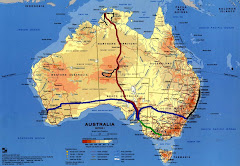What kind of tree is this? What kind of fruits are those???
Yay - that's right! These are Mango's!!! Wow!
And what is this stuff? Johannesbrotschoten mit Johannesbrotkernen. Weird!!!


On the way back to Darwin we drove through the township of Batchelor. Our tour guide told us, that this en miniature castle was build by a man from Roumania who was quite homesick. Unfortunately he died before he could finish it and see his work in its full beauty.

Proclaimed a national park in 1986, it is named after Fred Litchfield, a Territory pioneer, who explored areas of the Northern Territory from Escape Cliffs on the Timor Sea to the Daly River in 1864.

The sculptured mounds sometimes have elaborate and distinctive forms, such as those of the compass termite (Amitermes meridionalis & A. laurensis) which build tall wedge-shaped mounds with the long axis oriented approximately north-south. This orientation has been experimentally shown to help in thermoregulation.
We visited Florence Falls, Wangi Falls and Buley Rockholes and walked through beautiful rain forests
Uranium was discovered outside what is now Litchfield’s eastern boundary in August 1949, by a local prospector, Jack White. Australia’s first fully operational uranium mine was opened at Rum Jungle, and underground mining occurred from 1950 to 1953.















No comments:
Post a Comment